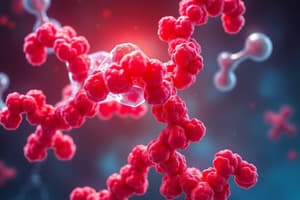Podcast
Questions and Answers
What is the role of serine proteases in relation to PAR family receptors?
What is the role of serine proteases in relation to PAR family receptors?
- They enhance receptor binding by increasing ligand concentration.
- They block receptor activity through competitive inhibition.
- They provide structural support to the receptors.
- They induce proteolysis to activate or inactivate the receptors. (correct)
Which of the following cellular actions is NOT mentioned as a contribution of the PAR family?
Which of the following cellular actions is NOT mentioned as a contribution of the PAR family?
- Homeostasis
- Inflammation
- Cell survival
- Cell division (correct)
Which cleaving agent specifically acts on PAR2?
Which cleaving agent specifically acts on PAR2?
- Neutral endopeptidase
- Thrombin
- Cathepsin G
- Trypsin (correct)
Which action is performed by thrombin related to PARs?
Which action is performed by thrombin related to PARs?
What two signaling pathways are primarily affected by the PAR family?
What two signaling pathways are primarily affected by the PAR family?
Which enzymes are specifically mentioned to cleave active soluble hormones?
Which enzymes are specifically mentioned to cleave active soluble hormones?
What type of elements comprise about 2% of the human genome?
What type of elements comprise about 2% of the human genome?
Which residue is essential in the catalytic domain of serine proteases?
Which residue is essential in the catalytic domain of serine proteases?
What role does the Hirudin-like site play in thrombin binding?
What role does the Hirudin-like site play in thrombin binding?
Which statement about PAR 3 is correct?
Which statement about PAR 3 is correct?
What are the two types of PAR internalization?
What are the two types of PAR internalization?
Which internalization mechanism is known for regulating receptor activity post-activation?
Which internalization mechanism is known for regulating receptor activity post-activation?
How does the cleaved receptor interact with uncleaved receptors?
How does the cleaved receptor interact with uncleaved receptors?
What is the function of the tethered ligand domain in relation to PAR?
What is the function of the tethered ligand domain in relation to PAR?
PAR 4 is unique in its lack of which feature?
PAR 4 is unique in its lack of which feature?
What percentage of known GPCRs in the human genome is classified as Class I orphans?
What percentage of known GPCRs in the human genome is classified as Class I orphans?
What term is used to refer to receptors whose endogenous ligands have not yet been identified?
What term is used to refer to receptors whose endogenous ligands have not yet been identified?
What approach is mentioned in the context of drug discovery for orphan receptors?
What approach is mentioned in the context of drug discovery for orphan receptors?
Which of the following is an example of an adopted orphan receptor in the GPCR family?
Which of the following is an example of an adopted orphan receptor in the GPCR family?
How are orphan receptors generally designated in nomenclature?
How are orphan receptors generally designated in nomenclature?
What percentage of Class I receptors in the human genome are classified as known?
What percentage of Class I receptors in the human genome are classified as known?
What is the range of GPCRs in the human genome with identified ligands?
What is the range of GPCRs in the human genome with identified ligands?
Which method is NOT mentioned as a measure for assessing receptor activity?
Which method is NOT mentioned as a measure for assessing receptor activity?
Flashcards
Orphan receptor
Orphan receptor
A receptor with a similar structure to other known receptors but its natural ligand (the molecule it binds to) hasn't been discovered yet.
Protease-Activated Receptors (PARs)
Protease-Activated Receptors (PARs)
A special type of G protein-coupled receptor (GPCR) activated by proteolytic cleavage (breaking down proteins). This means they're activated by enzymes that cut proteins, not by traditional ligand binding.
What is a key feature of orphan receptors?
What is a key feature of orphan receptors?
Their endogenous ligand, the molecule they normally bind to, remains unidentified.
Adopted orphan receptors
Adopted orphan receptors
Signup and view all the flashcards
How are GPCR orphan receptors named?
How are GPCR orphan receptors named?
Signup and view all the flashcards
What is the 'reverse pharmacology' approach?
What is the 'reverse pharmacology' approach?
Signup and view all the flashcards
List some examples of adopted orphan receptors
List some examples of adopted orphan receptors
Signup and view all the flashcards
What are some methods used to screen for orphan receptor ligands?
What are some methods used to screen for orphan receptor ligands?
Signup and view all the flashcards
Tethered Ligand
Tethered Ligand
Signup and view all the flashcards
Hirudin-like Site
Hirudin-like Site
Signup and view all the flashcards
PAR3 Co-factoring
PAR3 Co-factoring
Signup and view all the flashcards
PAR Activation & Internalization
PAR Activation & Internalization
Signup and view all the flashcards
Ubiquitin-mediated Internalization
Ubiquitin-mediated Internalization
Signup and view all the flashcards
Clathrin-coated Pit Mediated Internalization
Clathrin-coated Pit Mediated Internalization
Signup and view all the flashcards
Plasma PK Cleavage Site
Plasma PK Cleavage Site
Signup and view all the flashcards
Tethered Ligand Domain
Tethered Ligand Domain
Signup and view all the flashcards
PARs
PARs
Signup and view all the flashcards
Serine Proteases
Serine Proteases
Signup and view all the flashcards
How do PARs work?
How do PARs work?
Signup and view all the flashcards
What are some cellular responses triggered by PARs?
What are some cellular responses triggered by PARs?
Signup and view all the flashcards
Thrombin & PARs
Thrombin & PARs
Signup and view all the flashcards
Trypsin & PARs
Trypsin & PARs
Signup and view all the flashcards
PARs: Activation vs. Inactivation
PARs: Activation vs. Inactivation
Signup and view all the flashcards
Study Notes
Protease-Activated Receptors (PARs)
- PARs are a family of G protein-coupled receptors (GPCRs) activated by proteolytic cleavage.
- Proteolytic cleavage exposes a tethered ligand domain within the receptor, which then binds and activates the receptor, initiating signaling cascades.
- The cleavage is usually performed by serine proteases.
- Examples of serine proteases that activate PARs include thrombin (acts on PAR1, 3, and 4) and trypsin (acts on PAR2).
- PARs contribute to tissue responses to injury including repair, homeostasis, cell survival, inflammation, and pain transmission.
- PARs function through the actions of various pathways including Gi (cAMP inhibitory), 12/13 (Rho and Ras activation), and q (calcium signaling).
- Proteases comprise roughly 2% of the human genome, and have diverse biological functions, often including cleaving a ligand or receptor.
Orphan Receptors
- Orphan receptors are GPCRs with no identified endogenous ligand.
- There are approximately 210 known ligand receptors, and 160 receptors with unknown ligand or function.
- Half of the human genome encodes sensory receptors, with approximately 360 receptors.
- If an orphan receptor's ligand is discovered later, the receptor is termed an "adopted orphan receptor" and is usually given the GPR followed by a number (e.g., GPR1).
- Classification of known and orphan GPCRs: 39% class I known, 37% class I orphans, 6% class II orphans, and 5% class II known.
Identification of Ligands/Deorphanization
- Methods of identifying ligands for orphan receptors include:
- Screening known ligands (e.g., from compound libraries).
- Screening biological extracts (e.g., from biological sources).
- Methods include an assay following screening to identify potential ligands.
- "Reverse pharmacology" is a useful approach.
- Assays include calcium measurement, cAMP measurement, internalization of tagged receptors, arachidonic acid release (PLA2), and electrophysiology.
Examples of Adopted Receptors
- Examples of adopted orphan receptors (part of the GPCR family) include the histamine H4 receptor, orexin receptor, and prolactin-releasing peptide receptor.
- Examples of adopted orphan receptors (part of the nuclear receptor group) include farnesoid X receptor (FXR), liver X receptor (LXR), and peroxisome proliferator-activated receptor (PPAR).
Proteases for PARs
- Thrombin acts on PARs 1, 3, and 4; Trypsin acts on PAR 2.
- Many proteases are produced during tissue damage.
- Many proteases rely on serine residues in their catalytic domains to induce proteolysis.
- Cleavage sites often include Lysine (K) and Arginine (R).
- Examples of Proteases:
- TACE and ACE
Example Proteases
- TACE and ACE cleave the precursors of active soluble hormones.
- Neutral endopeptidase inactivates neuropeptide substance P.
- Cleavage of special GPCRs (PARs) on cell membranes can cause receptor activation.
PAR Activation
- Thrombin binds to PAR 1/3 due to the presence of a hirudin-like site.
- It cleaves the peptide sequence of the receptor's N-terminal and allows the binding of tethered ligands to the receptor.
- Binding to one receptor can facilitate cleavage of another receptor on the same cell (e.g. PAR3 and PAR4).
PAR Internalization
- There are two types of PAR internalization: constitutive and agonist-induced internalization.
- Following activation, PARs are regulated by ubiquitin-mediated internalization and clathrin-coated pits mediated internalization.
Studying That Suits You
Use AI to generate personalized quizzes and flashcards to suit your learning preferences.




